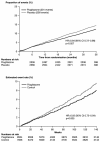Thiazolidinediones and cardiovascular risk - a question of balance
- PMID: 20676274
- PMCID: PMC2822138
- DOI: 10.2174/157340309788970333
Thiazolidinediones and cardiovascular risk - a question of balance
Abstract
Background: Several recent meta-analyses of adverse event data from randomized controlled trials with rosiglitazone reveal a possible association between this thiazolidinedione and an increased risk of ischemic myocardial events. This has led to debate on the overall clinical benefit of glitazone therapy for type 2 diabetes. Pioglitazone, on the other hand, has the most extensive cardiovascular outcomes database of all current glucose-lowering therapies, including a large prospective randomized controlled trial designed specifically to assess cardiovascular outcomes (PROactive). The available data suggest that pioglitazone is associated with a reduction in macrovascular risk.
Aims: In this review, we highlight some of the key factors that need to be considered when assessing the net clinical benefit of thiazolidinediones, focussing on both class effects and those specific to either rosiglitazone or pioglitazone.
Results: For pioglitazone there appears to be no increase in the risk of overall macrovascular events and no adverse clinical consequences of developing signs of heart failure. Furthermore, there is good evidence of significant benefit regarding the composite of death, MI or stroke.
Conclusion: The benefits seen with pioglitazone appear to outweigh the risks.
Figures




Similar articles
-
Thiazolidinediones in type 2 diabetes: a cardiology perspective.Ann Pharmacother. 2008 Oct;42(10):1466-74. doi: 10.1345/aph.1K666. Epub 2008 Sep 2. Ann Pharmacother. 2008. PMID: 18698014 Review.
-
The effect of pioglitazone on recurrent myocardial infarction in 2,445 patients with type 2 diabetes and previous myocardial infarction: results from the PROactive (PROactive 05) Study.J Am Coll Cardiol. 2007 May 1;49(17):1772-80. doi: 10.1016/j.jacc.2006.12.048. Epub 2007 Apr 16. J Am Coll Cardiol. 2007. PMID: 17466227 Clinical Trial.
-
Pioglitazone, rosiglitazone, and rosiglitazone + metformin: new drugs. Glitazone + oral antidiabetic combination: inadequately evaluated.Prescrire Int. 2005 Aug;14(78):133-9. Prescrire Int. 2005. PMID: 16106595
-
EMPA-REG and Other Cardiovascular Outcome Trials of Glucose-lowering Agents: Implications for Future Treatment Strategies in Type 2 Diabetes Mellitus.Clin Ther. 2016 Jun;38(6):1288-1298. doi: 10.1016/j.clinthera.2016.04.037. Epub 2016 May 19. Clin Ther. 2016. PMID: 27210264
-
Thiazolidinediones: effects on the development and progression of type 2 diabetes and associated vascular complications.Diabetes Metab Res Rev. 2009 Feb;25(2):112-26. doi: 10.1002/dmrr.937. Diabetes Metab Res Rev. 2009. PMID: 19219860 Review.
Cited by
-
Pharmacological modulation of cell death in atherosclerosis: a promising approach towards plaque stabilization?Br J Pharmacol. 2011 Sep;164(1):1-13. doi: 10.1111/j.1476-5381.2011.01342.x. Br J Pharmacol. 2011. PMID: 21418184 Free PMC article. Review.
-
Can the electrophysiological action of rosiglitazone explain its cardiac side effects?Curr Med Chem. 2011;18(24):3720-8. doi: 10.2174/092986711796642364. Curr Med Chem. 2011. PMID: 21774756 Free PMC article.
-
PPARγ inhibition regulates the cell cycle, proliferation and motility of bladder cancer cells.J Cell Mol Med. 2019 May;23(5):3724-3736. doi: 10.1111/jcmm.14280. Epub 2019 Mar 25. J Cell Mol Med. 2019. PMID: 30912275 Free PMC article.
-
Shared and distinct mechanisms of fibrosis.Nat Rev Rheumatol. 2019 Dec;15(12):705-730. doi: 10.1038/s41584-019-0322-7. Epub 2019 Nov 11. Nat Rev Rheumatol. 2019. PMID: 31712723 Review.
-
The role of peroxisome proliferator-activated receptors in carcinogenesis and chemoprevention.Nat Rev Cancer. 2012 Feb 9;12(3):181-95. doi: 10.1038/nrc3214. Nat Rev Cancer. 2012. PMID: 22318237 Free PMC article. Review.
References
-
- Nathan DM, Buse JB, Davidson MB, et al. Professional Practice Committee, American Diabetes Association; European Association for the Study of Diabetes. Management of hyperglycaemia in type 2 diabetes: a consensus algorithm for the initiation and adjustment of therapy. A consensus statement from the American Diabetes Association and the European Association for the Study of Diabetes. Diabetologia. 2006;49:1711–1721. - PubMed
-
- Nathan DM, Buse JB, Davidson MB, et al. Management of hyperglycaemia in type 2 diabetes mellitus: a consensus algorithm for the initiation and adjustment of therapy: Update regarding the thiazolidinediones. Diabetologia. 2008;51:8–11. - PubMed
-
- Jellinger PS, Davidson JA, Blonde L, et al. Road maps to achieve glycemic control in type 2 diabetes mellitus: ACE/AACE Diabetes Road Map Task Force. Endocr Pract. 2007;13:260–268. - PubMed
-
- Bolen S, Feldman L, Vassy J, et al. Systematic review: comparative effectiveness and safety of oral medications for type 2 diabetes mellitus. Ann Intern Med. 2007;147:386–399. - PubMed
-
- Vasudevan AR, Balasubramanyam A. Thiazolidinediones: a review of their mechanisms of insulin sensitization, therapeutic potential, clinical efficacy, and tolerability. Diabetes Technol Ther. 2004;6:850–863. - PubMed
LinkOut - more resources
Full Text Sources

